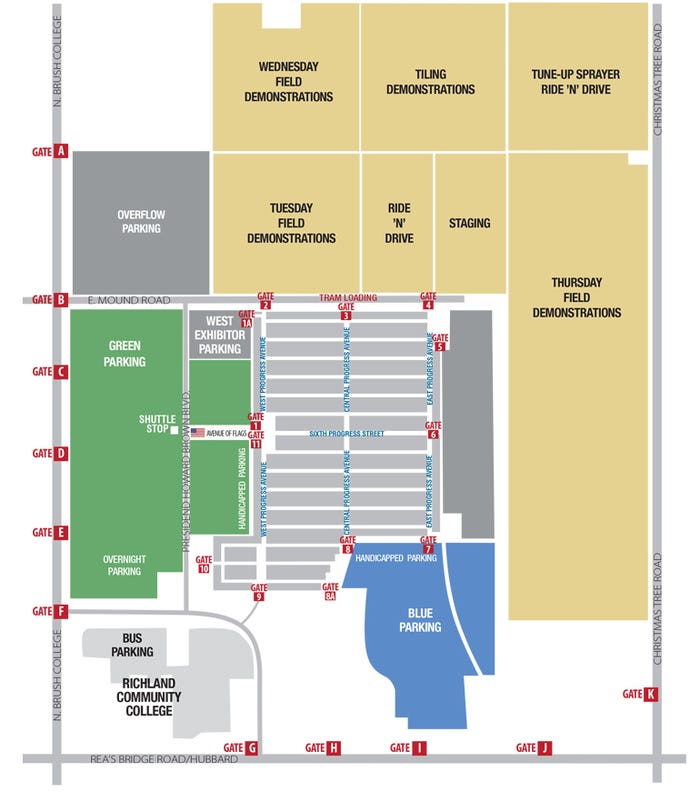
Getting your crops planted this spring was likely a struggle. The Farm Progress Show host farmers weren’t immune from those difficulties. While corn is usually planted early around Decatur, Ill., this year was an exception. Continuing rain showers forced delays.
The good news for showgoers is that corn on demonstration fields was finally planted in mid-May, and show manager Matt Jungmann expects combine and tillage demos to happen as planned.
“We had to change hybrid selections twice to get a hybrid we felt confident could mature in time,” he says. Normally, the hosts would plant 94-day hybrids on fields used for tune-up and field demonstrations.
“This year we wound up with 85-day hybrids,” Jungmann says. “They were able to plant these fields May 17. If our projections hold true, corn should reach black layer about 10 to 15 days before the show.”
Corn is typically 30% to 35% moisture at black layer, which is physiological maturity for corn. Combine operators provided by the companies are usually accustomed to running corn with relatively high moisture content, Jungmann notes.
Combine demos
Corn combining demonstrations will kick off at 11 a.m. each morning of the show, Aug. 27-29, says Ed Harris, who works with equipment operators on behalf of show staff. Harris is in the retail input business, now part of Nutrien. He’s assisted by Mat Muirhead, who works with him during the show.
“The first thing we do is meet with equipment operators who will run machines in the field the day before the show,” Harris says. “Equipment vendors choose who they want to operate their equipment. We don’t train them. Instead, we trust that the vendors are choosing experienced operators that know what they’re doing.”
However, Harris and Muirhead make sure each person who will operate a combine or tractor in the field understands the rules. “Show organizers place a high priority on practicing safety in the field,” Harris says. “It applies to the drivers of the equipment and to visitors who come out to the field to watch.”
Before each combine run, Harris or Muirhead read information provided by vendors at the meeting the day before. Once each combine has the chance to make a pass, they operate without stopping until they finish the section allotted for harvest that day.
“Two hours are allotted for combine demos, but we typically finish in about an hour,” Harris says. That’s a testament to larger combines and bigger corn heads that companies bring to the field for people to see in action.
Tillage time
Tillage tools take over from 2 to 3 p.m. in stalk fields, which were combined that morning, Harris says. Expect to see almost every brand of tractor and every type of tillage tool imaginable during these demonstrations. Companies exhibiting at the show determine which tillage tools they will demonstrate, and what tractors will pull each implement.
Expect to see everything from chisel plows to specialty tools, Harris says. Vertical tillage tools make up a good percentage of the tools operating today. Several companies are introducing precision tillage tools that can be adjusted from the cab. Some can adjust to preset operating parameters with the touch of a button on a screen. Some of these tools will likely be in action, as well.
The tillage tool format is similar for combining, with each tool making a pass, and then all operators working to finish the field after their first pass. Drivers representing companies choose operating speed for their tools.
“It’s especially important to follow safety rules when these tools are operating,” Harris says. “We require that all operators stay behind a rope line, which we maintain with our crew. We keep it approximately 20 feet back from moving equipment. We try to keep the line as straight as possible so that everyone has a good opportunity to watch the equipment run, while staying a safe distance away.”
FS sponsors pennants used in the demonstrations. The company also supplies various inputs, including fuel for field demonstrations.
Field tips
Trams will be available for those who have trouble walking to the field. Trams will load and unload on the north end of Central Avenue. Keep all hands and feet inside the tram, and enter or exit only when it has stopped for pickup or drop-off.
If you take a golf car to the field, please follow all instructions from those in charge, Harris says. They will be easy to spot, wearing orange vests. Also, be courteous to visitors on foot.
Ride ’n’ Drive areas will be provided for companies who want to give customers a close look at their equipment. These go on continuously during show hours. If changes are necessary, they will be posted in convenient locations. Enjoy watching the action and stay safe!
Below is a map showing the locations of the field demos.

About the Author(s)
You May Also Like




